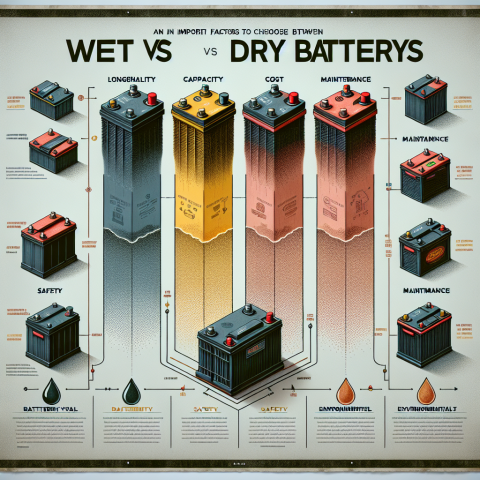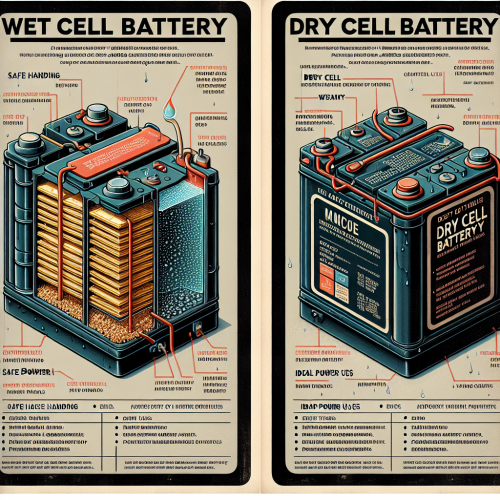Wet vs Dry Batteries – Ah, batteries. We all know they keep our gadgets running smoothly, but did you know there are two main types you’re likely to encounter—wet and dry batteries? If you’re like me, you probably thought they were basically the same, just different names. But over time, I’ve realized there’s way more to it. Whether you’re using a battery for your car, a flashlight, or even an energy storage system, understanding the differences between wet and dry batteries can save you a lot of headaches and money. Trust me, I’ve learned this the hard way.
I remember the first time I had to replace my car battery. I was at the auto shop, and the mechanic mentioned that I needed a dry battery because it was more suitable for the temperatures in my area. I was clueless, so I just nodded, handed over my credit card, and hoped for the best. Turns out, there’s actually quite a bit of thought that goes into selecting the right type of battery for your needs. So, if you’re in the same boat, let’s break it down: Here are six important factors to consider when choosing between wet and dry batteries.

Wet vs Dry Batteries: 6 Important Factors to Consider
1. Battery Type: Wet vs. Dry Explained
To start, you should know the key difference between wet and dry batteries. Wet batteries (also known as flooded batteries) are filled with liquid electrolyte, typically a mixture of water and sulfuric acid. This makes them heavier and more prone to leakage, especially if they’re not maintained properly. I learned this the hard way with a motorcycle battery once—kept it in a cold garage, and it leaked. Not pretty.
On the other hand, dry batteries (sealed lead-acid batteries or SLA) are sealed and contain a gel or absorbed glass mat (AGM) that holds the electrolyte in place. They don’t require as much maintenance and are less likely to leak, which is why they’re great for things like RVs or vehicles where you don’t want to fuss with checking fluid levels constantly. I’ve since switched to dry batteries for most of my outdoor equipment—way easier to manage.
2. Maintenance Needs: Do You Want to Baby Your Battery?
If you’re someone who doesn’t mind a little extra upkeep, then wet batteries might be okay for you. But if you’re like me and prefer things that just work without constant attention, you’ll probably lean toward dry batteries. Wet batteries require regular checking and topping off of the electrolyte levels, and if they’re not cared for, their performance can quickly decline.
I once had a wet battery in my car that I forgot to check for months. When I finally did, the water levels were so low that the battery was barely holding a charge. That was an expensive lesson—don’t skip battery maintenance!
Dry batteries, however, are usually sealed and maintenance-free, which makes them much more convenient. No worrying about water levels or cleaning terminals. You can install them and pretty much forget about them for a while—assuming they’re good quality. In my experience, this alone has saved me time and money over the years.
3. Cost: Are You Willing to Pay a Premium?
Now, I don’t know about you, but I always get sticker shock when I see the price difference between wet and dry batteries. Dry batteries typically come with a higher price tag, and while they do offer benefits like better reliability and less maintenance, that initial cost can sting.
I was shocked when I had to replace the battery in my motorcycle—it was a sealed AGM dry battery, and it cost a good chunk more than the wet battery alternative. But looking back, I realized that extra cost was worth it. The dry battery lasted longer, required less fussing, and performed better overall.
Wet batteries are usually cheaper, and for short-term or occasional use, they can be a solid choice. But if you’re looking for a long-term investment and a no-hassle experience, the dry battery might end up being a better value in the long run.
4. Temperature Sensitivity: How’s the Weather in Your Area?
Here’s a fun fact I didn’t know until I ran into trouble: wet batteries are more temperature-sensitive. They don’t like extreme cold or heat, and if you live in a place with drastic temperature swings, they might not perform as well.
Take my experience with a wet battery in a truck I owned a few years ago. One particularly cold winter, I had trouble starting my truck every morning. It was a wet battery, and the cold really affected its performance. In hindsight, I should’ve gone with a dry battery that could handle the freezing temperatures better.
Dry batteries, especially AGM batteries, are much more tolerant of temperature changes. They perform better in both hot and cold climates, which is why I’ve switched to them in all my outdoor vehicles. If you’re in an area where the weather varies a lot, a dry battery will likely save you some headaches and inconvenience.
5. Lifespan: Do You Want a Long-Lasting Battery?
Ah, the longevity factor. Dry batteries tend to have a longer lifespan than wet batteries. This is partly due to their sealed design, which reduces the chances of corrosion and electrolyte leakage that can damage the internal components. Plus, they’re less likely to be affected by extreme temperatures and have less self-discharge.
I’ve had a dry battery in my RV for several years now, and it’s still going strong. On the other hand, I’ve had wet batteries in some of my other vehicles that needed to be replaced much sooner. The longer lifespan of dry batteries means less frequent replacements, which ultimately saves you money in the long run.
6. Applications: What Are You Using the Battery For?
Lastly, consider what you’re using the battery for. Wet batteries are great for cars and other vehicles that get regular use. They’re reliable, widely available, and cost-effective. But if you’re using the battery in something that requires more consistent performance (like a solar power system, deep cycle battery, or a motorcycle), you might want to lean toward dry batteries. The sealed design, longer lifespan, and ability to withstand tougher conditions make them ideal for these more demanding applications.
I use dry batteries in my camping and boating gear now because they hold up better in those situations. Whether I’m using an RV, an electric cooler, or a boat motor, I know the dry batteries are going to perform when I need them most, without worrying about leaks or performance dips.
In conclusion, choosing between wet and dry batteries really comes down to what you’re using them for, how much maintenance you’re willing to do, and what kind of climate you live in. Wet batteries are great if you don’t mind a little extra care and want to save money upfront, but dry batteries are often worth the investment for convenience, longer life, and better performance in tough conditions. The right choice for you depends on your needs, but hopefully, after reading this, you’re feeling a bit more informed to make the best decision.







